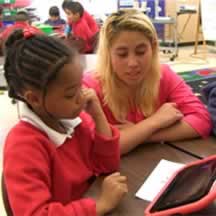VINCI’s model combines hands-on, experiential learning with software that identifies early learning gaps
Susan Kelly is excited about the possibilities when her school welcomes its first class of students this fall.
Kelly is the vice principal of VINCI School [1] in Ottawa, Canada, one of a series of new early learning schools that model the approach of VINCI Education: a hands-on blend of low-tech and high-tech instruction, guided by a skilled classroom teacher.
Though Ottawa’s VINCI School officially opens in September for children ages 3-8, the school has been teaching a few five-year-old students on a pilot basis this spring—and Kelly has seen its approach to learning already pay off.
The VINCI School will borrow from some of the best instructional models available, combining them into “what we feel is the perfect pedagogy,” said Kelly, a former teacher who served as principal at another Ottawa elementary school before joining the VINCI staff.
For instance, the school will use a structured Montessori approach for teaching some concepts, while for others, it will adopt the Reggio Emilia style of learning, in which students explore an activity on their own—leading to creativity and self-discovery.
In one recent activity, the pilot students were experimenting with ramps to see which objects would roll the fastest and farthest. “The students were just so creative,” Kelly said. “It was interesting to watch. And they were super excited about it.”
Supporting this experiential approach to learning is a “technology-enabled” curriculum, Kelly said, in which students will use tablet computers designed specifically for young children to practice math, science, and language-arts skills.
The tablets and curriculum come from VINCI Education [2], whose ClassVINCI solution includes more than 70 digital games and lessons and is available for purchase by other institutions. Each activity is rooted in cognitive science and is aligned with the Common Core State Standards.
See also:
The digital games are accompanied by a robust learning management system that teachers can use to schedule and assign specific activities for their students, Kelly said.
And while the children are working on these activities, the software closely tracks and analyzes their progress—giving teachers an easy way to see if their students have grasped the material.
“Teachers can see exactly how each child is doing—how many times the children have attempted a lesson, and whether they were successful or not,” Kelly said. This allows teachers to hone in on concepts that are giving their students problems and offer more personalized, one-on-one support.
This blend of low-tech and high-tech strategies is “really a different approach” to early learning, Kelly said. She added: “Rather than sitting at a desk, learning from a textbook, students will be learning by doing. That’s exciting for me.”
What’s more, students at the VINCI School will be encouraged to work ahead at their own pace, achieving whatever they put their minds to accomplishing.
“If you raise the bar, students will try to achieve more—they will work toward that goal,” Kelly said. “If you lower the bar, nobody wins. We’re not setting artificial limits on the kids, like grade-level limits—instead, the sky is the limit.”
